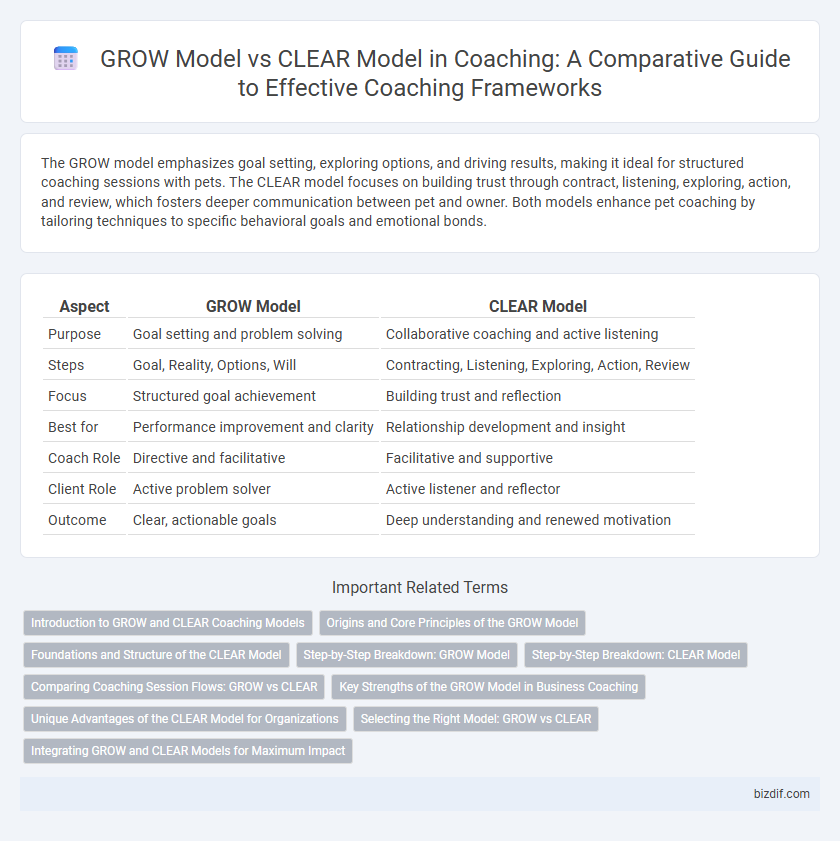The GROW model emphasizes goal setting, exploring options, and driving results, making it ideal for structured coaching sessions with pets. The CLEAR model focuses on building trust through contract, listening, exploring, action, and review, which fosters deeper communication between pet and owner. Both models enhance pet coaching by tailoring techniques to specific behavioral goals and emotional bonds.
Table of Comparison
| Aspect | GROW Model | CLEAR Model |
|---|---|---|
| Purpose | Goal setting and problem solving | Collaborative coaching and active listening |
| Steps | Goal, Reality, Options, Will | Contracting, Listening, Exploring, Action, Review |
| Focus | Structured goal achievement | Building trust and reflection |
| Best for | Performance improvement and clarity | Relationship development and insight |
| Coach Role | Directive and facilitative | Facilitative and supportive |
| Client Role | Active problem solver | Active listener and reflector |
| Outcome | Clear, actionable goals | Deep understanding and renewed motivation |
Introduction to GROW and CLEAR Coaching Models
The GROW coaching model, centered on Goal, Reality, Options, and Will, facilitates structured problem-solving and goal achievement by guiding clients through clear, actionable steps. The CLEAR model, comprising Contracting, Listening, Exploring, Action, and Review, emphasizes deeper client engagement and continuous feedback to foster personal insights and sustained development. Both models are widely used in coaching for enhancing clarity, motivation, and progress, with GROW focusing on goal-oriented outcomes and CLEAR promoting reflective learning processes.
Origins and Core Principles of the GROW Model
The GROW model, developed in the 1980s by Sir John Whitmore and colleagues at Performance Consultants International, originated as a practical framework for goal-setting and problem-solving in coaching. Its core principles encompass four stages: Goal setting (defining clear objectives), Reality assessment (understanding the current situation), Options exploration (identifying possible paths), and Will (commitment to action). This structured, outcome-oriented approach contrasts with the CLEAR model, which emphasizes building rapport, listening actively, exploring emotions, and facilitating awareness throughout the coaching conversation.
Foundations and Structure of the CLEAR Model
The CLEAR model, developed by Peter Hawkins, is grounded in five core stages: Contracting, Listening, Exploring, Action, and Review, emphasizing a flexible, dynamic coaching process rooted in trust and deep communication. Unlike the GROW model's linear structure--Goal, Reality, Options, Will--CLEAR prioritizes relational foundations and ongoing dialogue to adapt to coachee needs. Its structure fosters emotional insight and awareness, enabling coaches to navigate complex issues by continuously contracting and reviewing the coaching relationship.
Step-by-Step Breakdown: GROW Model
The GROW model consists of four key steps: Goal, Reality, Options, and Will, which guide the coaching process by first identifying clear objectives, then assessing the current situation realistically. Next, it explores various strategies or alternatives to achieve the goal, and finally, commits to actionable plans with motivation and timelines. This structured approach helps clients progress methodically toward their desired outcomes, making it a widely used framework in coaching sessions.
Step-by-Step Breakdown: CLEAR Model
The CLEAR model, developed by Peter Hawkins, structures coaching into five distinct steps: Contracting establishes the coaching agreement, Listening involves deep, active listening to understand the coachee's perspective, Exploring helps uncover insights and possibilities, Action focuses on setting clear, achievable goals, and Review assesses progress and learning outcomes. Each step emphasizes collaboration and reflection, fostering trust and clarity throughout the coaching process. This step-by-step breakdown enhances goal attainment and personal growth by addressing both emotional and practical aspects systematically.
Comparing Coaching Session Flows: GROW vs CLEAR
The GROW model structures coaching sessions by guiding clients through Goal setting, Reality assessment, Options exploration, and Will to act, creating a clear and linear flow. In contrast, the CLEAR model emphasizes a more flexible approach with Contracting, Listening, Exploring, Action, and Review phases, promoting deeper reflection and continuous feedback. Comparing these flows, GROW offers a straightforward path ideal for goal-oriented coaching, while CLEAR supports dynamic dialogue and adaptive progress.
Key Strengths of the GROW Model in Business Coaching
The GROW model excels in business coaching by providing a clear, step-by-step framework that enhances goal clarity, reality assessment, options exploration, and willpower commitment. Its structured approach promotes actionable outcomes and accountability, making it ideal for performance improvement and decision-making in corporate environments. The model's simplicity and adaptability allow coaches to address diverse business challenges effectively while fostering client empowerment and ownership of solutions.
Unique Advantages of the CLEAR Model for Organizations
The CLEAR model offers unique advantages for organizations by fostering a collaborative coaching environment that emphasizes Contracting, Listening, Exploring, Action, and Review. Unlike the more linear GROW model, CLEAR promotes deeper emotional engagement and continuous feedback, enhancing employee development and organizational agility. This approach is particularly effective in complex, dynamic workplaces where adaptability and relational transparency drive sustained performance improvement.
Selecting the Right Model: GROW vs CLEAR
Selecting the right coaching model depends on the client's goals and the desired structure of the session. The GROW model, emphasizing Goal-setting, Reality exploration, Options generation, and Will, suits clients seeking clear, step-by-step progress. In contrast, the CLEAR model, highlighting Contracting, Listening, Exploring, Action, and Review, is ideal for fostering deeper reflection and flexible, ongoing development.
Integrating GROW and CLEAR Models for Maximum Impact
Integrating the GROW and CLEAR coaching models enhances goal-setting and problem-solving effectiveness by combining GROW's structured framework (Goal, Reality, Options, Will) with CLEAR's emphasis on deeper listening and action-oriented reflection (Contracting, Listening, Exploring, Action, Review). This hybrid approach leverages GROW's clarity in defining objectives alongside CLEAR's focus on emotional intelligence and adaptive feedback, resulting in more personalized and sustainable coaching outcomes. Coaches using both models can facilitate comprehensive development that addresses both practical goals and underlying motivational factors for maximum impact.
GROW model vs CLEAR model Infographic

 bizdif.com
bizdif.com